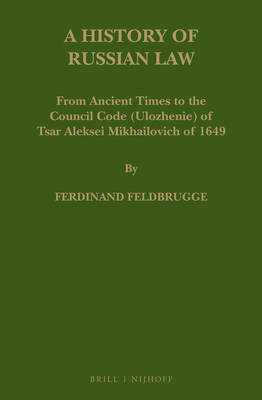
- Afhalen na 1 uur in een winkel met voorraad
- Gratis thuislevering in België vanaf € 30
- Ruim aanbod met 7 miljoen producten
- Afhalen na 1 uur in een winkel met voorraad
- Gratis thuislevering in België vanaf € 30
- Ruim aanbod met 7 miljoen producten
Zoeken
A History of Russian Law
From Ancient Times to the Council Code (Ulozhenie) of Tsar Aleksei Mikhailovich of 1649
Ferdinand J M Feldbrugge
€ 700,95
+ 1401 punten
Uitvoering
Omschrijving
The beginnings of Russian law are documented by the Russo-Byzantine treaties of the 10th century and the oldest Russian law, the Russkaia Pravda. The tempestuous developments of the following centuries (the incessant wars among the princes, the Mongol invasion, the rise of the Novgorod republic) all left their marks on the legal system until the princes of Muscovy succeeded in reuniting the country. This resulted in the creation of major legislative monuments, such as the Codes of Ivan the Great of 1497 and of Ivan the Terrible of 1550. After the Time of Troubles the Council Code of the second Romanov Tsar, Aleksei, of 1649 became the starting point for the comprehensive Russian codification of the 19th century. The next period of Russian legal history is the subject of vol. 70 of Law in Eastern Europe: "A History of Russian Law. From the Council Code (Ulozhenie) of Tsar Aleksei Mikhailovich of 1649 to the Bolshevik Revolution of 1917", Brill Nijhoff, 2023 .
Specificaties
Betrokkenen
- Auteur(s):
- Uitgeverij:
Inhoud
- Aantal bladzijden:
- 1118
- Taal:
- Engels
- Reeks:
- Reeksnummer:
- nr. 66
Eigenschappen
- Productcode (EAN):
- 9789004346420
- Verschijningsdatum:
- 20/10/2017
- Uitvoering:
- Hardcover
- Formaat:
- Genaaid
- Afmetingen:
- 157 mm x 239 mm
- Gewicht:
- 1179 g

Alleen bij Standaard Boekhandel
+ 1401 punten op je klantenkaart van Standaard Boekhandel
Beoordelingen
We publiceren alleen reviews die voldoen aan de voorwaarden voor reviews. Bekijk onze voorwaarden voor reviews.








